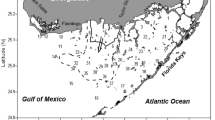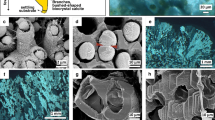Abstract
Calcium concentration and calcite supersaturation (Ω) needed for calcium carbonate nucleation and crystal growth in Pyramid Lake (PL) surface water were determined during August of 1997, 2000, and 2001. PL surface water has Ω values of 10–16. Notwithstanding high Ω, calcium carbonate growth did not occur on aragonite single crystals suspended PL surface water for several months. However, calcium solution addition to PL surface-water samples caused reproducible calcium carbonate mineral nucleation and crystal growth. Mean PL surface-water calcium concentration at nucleation was 2.33 mM (n = 10), a value about nine times higher than the ambient PL surface-water calcium concentration (0.26 mM); mean Ω at nucleation (109 with a standard deviation of 8) is about eight times the PL surface-water Ω. Calcium concentration and Ω regulated the calcium carbonate formation in PL nucleation experiments and surface water. Unfiltered samples nucleated at lower Ω than filtered samples. Calcium concentration and Ω at nucleation for experiments in the presence of added particles were within one standard deviation of the mean for all samples. Calcium carbonate formation rates followed a simple rate expression of the form, rate (mM/min) = A (Ω) + B. The best fit rate equation “Rate (Δ mM/Δ min) = −0.0026 Ω + 0.0175 (r = 0.904, n = 10)” was statistically significant at greater than the 0.01 confidence level and gives, after rearrangement, Ω at zero rate of 6.7. Nucleation in PL surface water and morphology of calcium carbonate particles formed in PL nucleation experiments and in PL surface-water samples suggest crystal growth inhibition by multiple substances present in PL surface water mediates PL calcium carbonate formation, but there is insufficient information to determine the chemical nature of all inhibitors.







Similar content being viewed by others
References
Addadi L, Raz S, Weiner S (2003) Taking advantage of disorder: amorphous calcium carbonate and its roles in biomineralization. Adv Mater 15:959–970
Arp G, Thiel V, Reimer A, Michaelis W, Reitner J (1999) Biofilm exopolymers control microbialite formation at thermal springs discharging into the alkaline Pyramid Lake, Nevada, USA. Sediment Geol 126:159–176
Bischoff JL, Stine S, Rosenbauer RJ, Fitzpatrick JA, Stafford TW Jr (1993) Ikaite precipitation by mixing of shoreline springs and lake water, Mono Lake, California, USA. Geochim Cosmochim Acta 57:3855–3865
Chave K, Seuss E (1970) Calcium carbonate supersaturation in seawater: effects of dissolved organic matter. Limnol Oceanogr 15:633–637
Cloud PE Jr (1962) Environment of calcium carbonate deposition west of Andros Island, Bahamas. U.S. Geol. Surv Professional Paper 350, p 138
De Yoreo JJ, Dove PM (2004) Shaping crystals with biomolecules. Science 306:1301–1302
Dean WE, Fouch TD (1983) Lacustrine environment. In: Scholle PA, Bebout DG, Moore CH (eds) Carbonate depositional environments, AAPG Memoir 33. The American Association of Petroleum Geologists, Tulsa, pp 98–130
Didymus JM, Oliver P, Mann S, DeVries AL, Hauschka PV, Westbroek P (1993) Influence of low-molecular-weight and macromolecular organic additives on the morphology of calcium carbonate. J Chem Soc Faraday Trans 89:2891–2900
Diehl H (1964) Calcein, calmagite, and o, o′-dihydroxyazobenzene. Titrimetric, colorimetric, and fluorometric reagents for calcium and magnesium. The G. Frederick Smith Chemical Company, Columbus
Dittrich M, Obst M (2004) Are picoplankton responsible for calcite precipitation in lakes? Ambio 33:553–558
Galat DL, Jacobsen RL (1985) Recurrent aragonite precipitation in saline-alkaline Pyramid Lake, Nevada. Arch Hydrobiol 105:137–159
Hamilton-Galat K, Galat DL (1983) Seasonal variation of nutrients, organic carbon, ATP, and microbial standing crops in a vertical profile of Pyramid Lake, Nevada. Hydrobiologia 105:27–43
He S, Kan AT, Tomson MB (1999) Inhibition of calcium carbonate precipitation in NaCl brines from 25 to 90°C. Appl Geochem 14:17–25
Herman JS (1989) A geochemical model of calcite precipitation and CO2 outgassing in karst streams. In: Miles DL (ed) Water-Rock Interaction, WRI-6. Balkema, Rotterdam, pp 301–304
Herman JS, Lorah MM (1988) Calcite precipitation rates in the field: measurement and prediction for a travertine-depositing stream. Geochim Cosmochim Acta 52:2347–2355
Higgins JA, Fischer WW, Schrag DP (2009) Oxygenation of the ocean and sediments: consequences for the seafloor carbonate factory. Earth Planet Sci Lett 284:25–33
Hodell DA, Schelske CL, Fahnenstiel GL, Robbins LL (1998) Biological induced calcite and its isotopic composition in Lake Ontario. Limnol Oceanogr 43:187–199
Kelts K, Hsü KJ (1978) Freshwater carbonate sedimentation. In: Lerman A (ed) Lakes: chemistry, geology, physics, chapter 9. Springer, New York, pp 294–323
Kile DE, Eberl DD, Hoch AR, Reddy MM (2000) An assessment of calcite crystal growth mechanisms based on crystal size distributions. Geochem Cosmochim Acta 64:2937–2950
Lebo ME, Reuter JE, Rhodes CL, Goldman CR (1993) Pyramid Lake, Nevada water quality study 1989-1993. Volume II. Limnological Description. University of California, Davis
Leenheer JA, Reddy MM (2008) Co-precipitation of dissolved organic matter by calcium carbonate in Pyramid Lake, Nevada. Ann Environ Sci 2:11–25
McConnaughey TA, LaBaugh JW, Rosenberry DO, Striegl RG, Reddy MM, Schuster PF, Carter V (1994) Carbon budget for a groundwater-fed lake: calcification supports summer photosynthesis. Limnol Oceanogr 39:1319–1332
McKenzie JA (1982) Carbon-13 cycle in Lake Greifen: a model for restricted ocean basins. In: Schlanger SO, Cita MB (eds) Nature and origin of cretaceous carbon-rich facies. Academic Press, Harcourt Brace Jovanovich, London, pp 197–207
Nancollas GH, Reddy MM (1971) The crystallization of calcium carbonate II. Calcite growth mechanism. J Colloid Interf Sci 37:824–830
Nancollas GH, Reddy MM (1974) The kinetics of crystallization of scale-forming minerals. Soc Petrol Eng J 14:117–126
Otsuki A, Wetzel RG (1974) Calcium and total alkalinity budgets and calcium carbonate precipitation of a small hard-water lake. Arch Hydrobiol (74):14–30
Parkhurst DL, Appelo CAJ (1999) User’s guide to PHREEQC (version 2)—a computer program for speciation, batch-reaction, one-dimensional transport, and inverse geochemical calculations. U.S. Geological Survey, Water-Resources Investigations Report 99-4259, 312 p
Plummer LN, Busenberg E, Riggs AC (2000) In situ growth of calcite at Devils Hole, Nevada: comparison of field and laboratory rates to a 500,000 year record of near-equilibrium calcite growth. Aquat Geochem 6:257–274
Reddy MM (1975) Kinetics of calcium carbonate formation. Proc Int Assoc Theor Appl Limnol 19:429–438
Reddy MM (1977) Crystallization of calcium carbonate in the presence of trace concentrations of phosphorus-containing anions I. Inhibition by phosphate and glycerophosphate ions at pH 8.8 and 25°C. J Cryst Growth 41:287–295
Reddy MM (1978) Kinetic inhibition of calcium carbonate formation by wastewater constituents. In: Rubin AJ (ed) The chemistry of waste-water technology (Chapter 3). Ann Arbor Science Publishers, Inc., Ann Arbor, pp 31–58
Reddy MM (1986) Effect of magnesium ion on calcium carbonate nucleation and crystal growth in dilute aqueous solutions at 25°C. In: Mumpton FA (ed) Studies in digenesis. U.S. Geological Survey Bulletin 1578, Denver, pp 169–182
Reddy MM (1995) Carbonate precipitation in Pyramid Lake, Nevada. In: Amjad Z (ed) Mineral scale formation and inhibition. Plenum Press, New York, pp 21–32
Reddy MM, Hoch AR (2000) Calcite crystal growth rate inhibition by aquatic humic substances. In: Amjad Z (ed) Advances in crystal growth inhibition technologies. Kluwer, New York, pp 107–121
Reddy MM, Hoch AR (2001) Calcite crystal growth rate inhibition by polycarboxylic acids. J Colloid Interf Sci 235:365–370
Reddy MM, Leenheer J (2011) Calcite growth rate inhibition by fulvic acids isolated from Big Soda Lake, Nevada, USA, the Suwannee River, Georgia, USA, and by Polycarboxylic Acids. Ann Environ Sci 5:41–53
Reddy MM, Nancollas GH (1973) Calcite crystal growth inhibition by phosphonates. Desalination 12:61–73
Reddy MM, Nancollas GH (1976) The crystallization of calcium carbonate IV. The effect of magnesium, strontium, and sulfate ions. J Cryst Growth 35:33–38
Reddy MM, Wang KK (1980) Crystallization of calcium carbonate in the presence of metal ions. I. Inhibition by magnesium ion at pH 8.8 and 25°C. J Cryst Growth 50:470–480
Reddy MM, Schuster PF, Harte JJ (1989) Summary of data from onsite and laboratory analyses of precipitation runoff from carbonate-stone surfaces. National Acid Precipitation Assessment Program, June 1984 to November 1987, U.S. Geological Survey Open File Report, 89-246, 19 p
Reynolds RC Jr (1978) Polyphenol inhibition of calcite precipitation in Lake Powell. Limnol Oceanogr 23:585–597
Rosen MR, Arehart GB, Lico MS (2004) Exceptionally fast growth rate of <100-yr-old tufa, Big Soda Lake, Nevada: Implications for using tufa as a paleoclimate proxy. Geology 32:409–412
Runnells DD (1969) Diagenesis, chemical sediments, and the mixing of natural water. J Sediment Petrol 39:1188–1201
Sarmiento JL, Gruber N (2006) Ocean biogeochemical dynamics. Princeton University Press, Princeton, p 503
Schuster PF, Reddy MM, LaBaugh JW, Parkhurst RS, Rosenberry DO, Winter TC, Antweiler RC, Dean WE (2003) Characterization of lake water and ground water movement in the littoral zone of Williams Lake, a closed-basin lake in north-central Minnesota. Hydrol Process 17:823–838
Tenzer GE, Meyers PA, Knoop P (1997) Sources and distribution of organic and carbonate carbon in surface sediments of Pyramid Lake, Nevada. J Sediment Res 67:884–890
Wetzel RG, White WS (1985) Alteration of iron-CaCO3 precipitation by yellow organic acids of aquatic angiosperm origin. Arch Hydrobiol 104:247–251
Weyl PK (1961) The carbonate saturometer. J Geol 69:32–44
Acknowledgments
The authors acknowledge help and encouragement of the PL Paiute Tribal Council and the PL Natural Resource Building staff during this work. Fieldwork was done with the assistance of David Fellenz (a USGS Volunteer, Lawrence University, Appleton, WI), Micaela Reddy (USGS Volunteer, Denver, CO), Julie Reddy (USGS Volunteer, Denver, CO), and Paul Schuster (USGS, NRP, CB, Boulder, CO). George Molino of Cutthroat Charters, Reno, NV, and Dan Mosley of the Pyramid Lake Piaute Tribe Environmental Department, Nixon, NV facilitated lake-water sampling logistics. Scott Charlton (USGS, NRP, BRR, CB, Denver, CO) assisted in data analysis and chemical speciation calculation. Charmaine Gunther (USGS, NRP, CB, Denver, CO) assisted in the preparation of the report. Review comments by David Parkhurst (USGS, NRP, CB, Denver, CO) and David Naftz (USGS, WRD, Salt Lake City, UT) and an anonymous reviewer significantly improved the manuscript. Anthony Hoch held a National Research Council-USGS Research Fellowship during this research. Funding for the work is by the USGS, NRP. The use of trade names and product names in this paper is for identification purposes only, and does not constitute endorsement by the USGS.
Author information
Authors and Affiliations
Corresponding author
Rights and permissions
About this article
Cite this article
Reddy, M.M., Hoch, A. Calcium Carbonate Nucleation in an Alkaline Lake Surface Water, Pyramid Lake, Nevada, USA. Aquat Geochem 18, 95–113 (2012). https://doi.org/10.1007/s10498-011-9150-3
Received:
Accepted:
Published:
Issue Date:
DOI: https://doi.org/10.1007/s10498-011-9150-3




